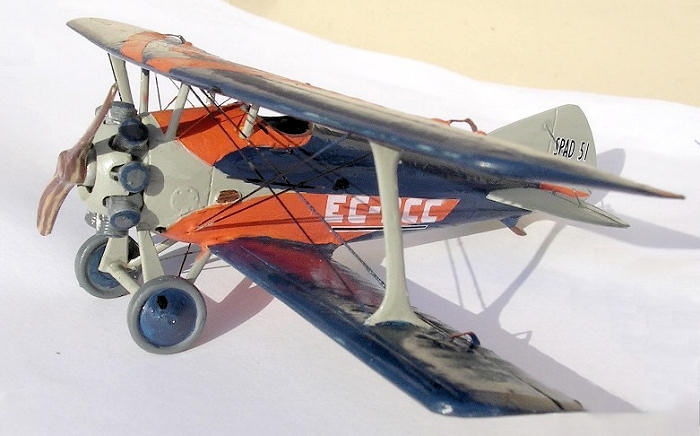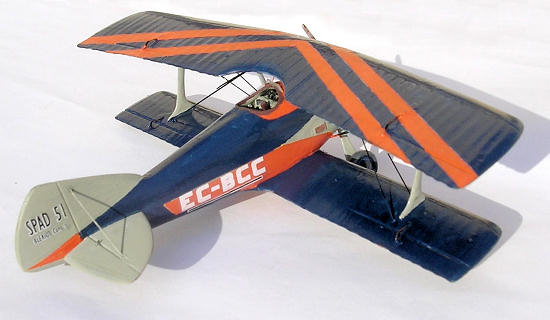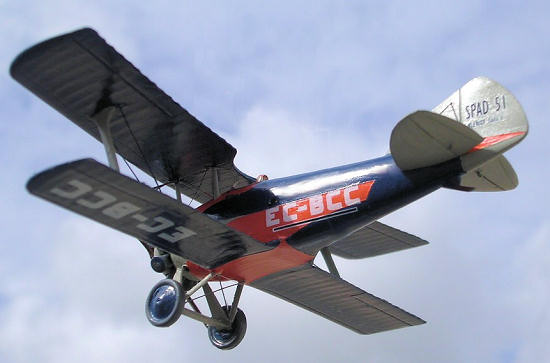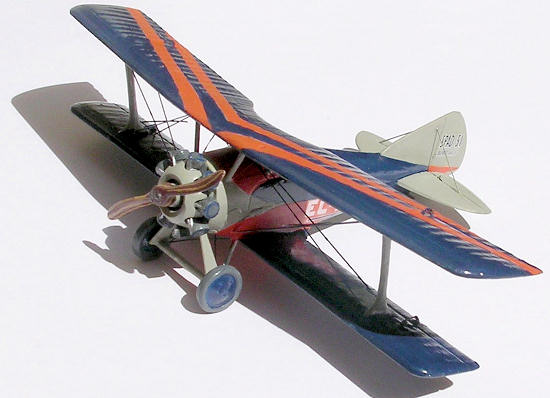
AZ 1/72 Bleriot-Spad S.51
| KIT #: | ? |
| PRICE: | £12.50 SRP |
| DECALS: | Five Options |
| REVIEWER: | Carmel J. Attard |
| NOTES: | Short Run Kit |

| HISTORY |
The
Bleriot-SPAD S.51
was a French fighter aircraft developed in 1924 in response to a
French Air Force requirement for an aircraft to replace their
obsolete
Nieuport-Delage ND29 Designed by
Andre Herbemont, the S.51 shared its basic configuration
 with
his other aircraft of the period, being a
biplane with a swept upper wing and unswept lower wing, joined by
I-shaped
interplane struts. The S.51, however, marked Herbémont's transition from
a covered framework fuselage design to a
monocoque fuselage.
with
his other aircraft of the period, being a
biplane with a swept upper wing and unswept lower wing, joined by
I-shaped
interplane struts. The S.51, however, marked Herbémont's transition from
a covered framework fuselage design to a
monocoque fuselage.
The
prototype S.51 was rejected by the French authorities, but revised versions
found export customers in the Polish Air Force, which bought 50 of them in
1926, and the Turkish and Soviet air forces which each bought a single
example. Another development, the S.51/3 was experimentally fitted with the
first controllable pitch propeller developed in France, also designed by Herbémont.
Around 64 aircraft were built and the primary users remain the Air Forces of
Poland , Turkey and Soviet Union. Some were also sold to the private sector.
One having registration EC-BCC belonged to the Aeroclub de Aragon for use as
a civil sports plane and flew during 1935 at Sanjurjo airfield, Spain
| THE KIT |
Comes packed in a colourful box having a Spad 51 flying over a war zone area
during the Spanish Civil War. This was displayed on one side of the box
cover and on the opposite side are two colour side views from the kit
offering. All these colour views
 proved
to be a good source of reference during the painting stage of the kit. This
is a delightful little model issued under the AZ model plastic kits label.
The Bleriot Spad S51 is in 1/72 scale and as far as I can see can be made
either as a civil or a military version, the significant difference being
externally which is the colour scheme that it can carry.
proved
to be a good source of reference during the painting stage of the kit. This
is a delightful little model issued under the AZ model plastic kits label.
The Bleriot Spad S51 is in 1/72 scale and as far as I can see can be made
either as a civil or a military version, the significant difference being
externally which is the colour scheme that it can carry.
The model comes in grey plastic with all the parts finely moulded with impressive detail such as the multi rippled surface detail above and below the wings. In spite of the diminutive size of the aircraft there is a comprehensive cockpit built out of brass etch that with great patience would result into a fantastic cockpit complete with front and side gauges, control stick, firewall and several other internal gadgets which are visible from the outside. There is a cockpit floor with resin seat complete with brass etch seat belts. Also in resin is a detailed 9 cylinder radial engine with two alternative front engine covers. There are also two different sizes of 2 bladed propellers. This is because the propeller mounted on the Polish version differed from that carried by all the other options.
| CONSTRUCTION |
The
kit itself is made out of 29 injection moulded parts, three resin items,
printed instruments and a brass fret with more instruments and interior
parts mentioned earlier. There are 15 stages of construction on the
instruction sheet with clear sketches that makes construction easy. The
front page contains a very brief history of the Spad 51 which includes also
brief technical data. The first four stages deal with careful assembly of
the highly detailed cockpit interior. This may be time consuming as it
contains a good number of small items. The rest deals with fixing the
exterior parts, assembling the butt jointed lower wings and tail planes
which I regard as a straight forward assembly after getting over the first
part.
 There
were a few anomalies encountered during the course of assembly. The cockpit
wind shield which is finely reproduced in clear acetate having a black
printed outline. This in fact is not of a rectangular shape as depicted on
the instruction sheet. I also noticed that the fuselage front and rear wing
struts needs to be reduced in length by 3mm on each part and I recommend
drilling a shallow locating hole at their joining part to the underside of
the upper wing. This will make it easy at a later stage when fixing these
struts correctly in their respective place.
I also noticed that when it comes to rigging the manner that the
bracing wire is indicated to be fixed on the instruction sheet differed from
that depicted on the box art that shows the Spad in flying configuration.
Incidentally I later discovered after reference to actual photos of the real
aircraft that the box art drawing have the correct rigging and should
therefore be referred to.
There
were a few anomalies encountered during the course of assembly. The cockpit
wind shield which is finely reproduced in clear acetate having a black
printed outline. This in fact is not of a rectangular shape as depicted on
the instruction sheet. I also noticed that the fuselage front and rear wing
struts needs to be reduced in length by 3mm on each part and I recommend
drilling a shallow locating hole at their joining part to the underside of
the upper wing. This will make it easy at a later stage when fixing these
struts correctly in their respective place.
I also noticed that when it comes to rigging the manner that the
bracing wire is indicated to be fixed on the instruction sheet differed from
that depicted on the box art that shows the Spad in flying configuration.
Incidentally I later discovered after reference to actual photos of the real
aircraft that the box art drawing have the correct rigging and should
therefore be referred to.
Another smaller item that needs correction is the smaller web attached to the tail skid. This should have the aft edge cut straight vertically rather than slanting. This is easily corrected using a fine smooth file. I also discovered that it would be a good idea if the rigging attached to the fuselage is best done if the engine sub assembly to the front fuselage is left to a later stage. This is particularly so if one is using the fine thread rigging method. So that the front opening will provide a good access to work out the thread passage. The engine parts are then fitted afterwards, thus blocking the access when all the rigging is done.
| COLORS & MARKINGS |
 The
kit can be finished as French, Russian, Polish, Turk, or Spanish air forces
as well as a Spanish civil registered model. These are intended to be
camouflaged in a dark shade of green upper and light blue lower with the
exception of the Spanish one which has a camouflage of sand and green on
upper surfaces and light blue lower. There is clear decal placement drawing
for all these offerings but in my case there were no decals for the military
type and my model catered for the Spanish civil version. I also noticed that
the camouflage detail for all the aircraft and with the exception of the
Spanish civil war aircraft were not provided. Obviously I had no alternative
than to make the civil Spad which incidentally carried a somewhat difficult
but a colourful scheme. The decal was well registered and opaque although
somewhat thin. Nevertheless the end result was very pleasing which
represented EC-BCC, a civil sports plane of Aero club de Aragon flown during
1935 at Sanjurjo airfield, Spain.
The
kit can be finished as French, Russian, Polish, Turk, or Spanish air forces
as well as a Spanish civil registered model. These are intended to be
camouflaged in a dark shade of green upper and light blue lower with the
exception of the Spanish one which has a camouflage of sand and green on
upper surfaces and light blue lower. There is clear decal placement drawing
for all these offerings but in my case there were no decals for the military
type and my model catered for the Spanish civil version. I also noticed that
the camouflage detail for all the aircraft and with the exception of the
Spanish civil war aircraft were not provided. Obviously I had no alternative
than to make the civil Spad which incidentally carried a somewhat difficult
but a colourful scheme. The decal was well registered and opaque although
somewhat thin. Nevertheless the end result was very pleasing which
represented EC-BCC, a civil sports plane of Aero club de Aragon flown during
1935 at Sanjurjo airfield, Spain.
| CONCLUSIONS |
Frankly speaking at first impression the Spad S 51 did not appeal much to me and also did not appear to offer an easy build. This was mainly due to the small size of the aircraft and so many tiny parts which obviously would provide a challenge to modellers especially to those who are used to working on larger models. However in spite of all and with some perseverance the end result was pleasing especially with the smart scheme provided for a civil, between wars era finish.
May 2009
Copyright ModelingMadness.com
If you would like your product reviewed fairly and quickly, please contact the editor or see other details in the Note to Contributors.